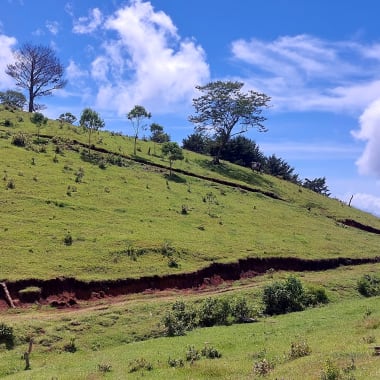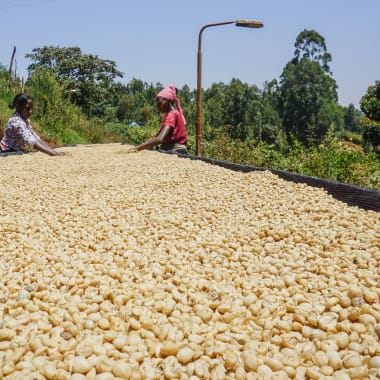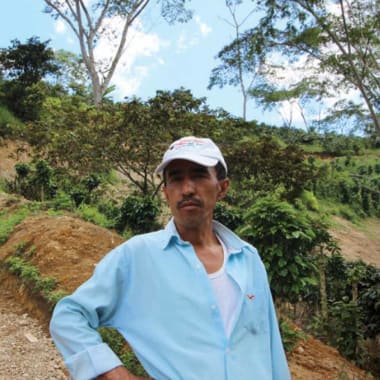-
Producer
-
Edwin Noreña
-
Farm/Coop
-
Finca Campo Hermoso
-
Country
- Colombia
-
Region
-
Quindío
-
Altitude
-
1650m above sea level
-
Variety
-
Process
-
Importer
-
Condesa Co.Lab
-
Body
-
-
Acidity
-
-
Tasting notes
-
Chinotto, musk stick, and passionfruit
-
Roast style
Colombia
Campo Hermoso
Pink Bourbon Purple HoneyThis microlot has gone through two fermentation stages: 96h carbonic maceration + 48h anaerobic semi-washed with the addition of ‘mosto’ (a coffee cherry juice that introduces extra sugars). We find flavours of jasmine, passion fruit and pineapple.
Woah there! This coffee has gone through two fermentation stages: 96h carbonic maceration + 48h anaerobic semi-washed with the addition of ‘mosto’ (a sort of coffee cherry juice that introduces extra sugars). Expect a boozy, complex, mind-boggling cup.
VERY SPECIAL
Aside from the exclusivity—it’s a tiny, delicious and high-quality Pink Bourbon lot— this coffee is a VS contender because it features a futuristic fermentation process, inspired by the winemaking industry: Purple Honey. Let’s learn more about it.

PURPLE HONEY PROCESS
1. Harvest and screening
The coffee cherries are harvested when they’re at the perfect ripe point—in this case, this is measured, so their sugar concentrations should go beyond 24°Bx.
°Bx, Degrees Brix or, more commonly, Brix is a measure of the dissolved solids in a liquid. It is commonly used in the wine, sugar, carbonated beverage, fruit juice, fresh produce, maple syrup and honey industries to measure the dissolved sugar content of an aqueous solution. For example, 1°Bx (or 1 Brix) is 1g of sucrose in 100g solution.

2. Initial 96h carbonic maceration.
The perfectly ripe cherries are soaked in water for 5 hours before undergoing an initial 12h carbonic maceration (also known as anaerobic natural fermentation with intact cherries—not crushed).
3. Partial depulping and secondary 48h anaerobic fermentation with mosto.
After this initial fermentation, the cherries are partially wet-milled (de-pulped), leaving ~75% of their mucilage, and put into a second 48h anaerobic fermentation mixed with ‘mosto’. This most is recirculated every 8 hours.
‘Mosto’ is a term taken from the winemaking industry, the English translation is ‘must’. It refers to the mix of crushed cherry pulp and juices—in this case, this mix is a concentrate of crushed cherry pulp made with cherries from other lots of the same variety.
The ‘mosto’ juice introduces additional sugars to the fermentation process, resulting in a larger amount of acids and/or alcohol to be broken down. (So, essentially, more fruity boozy flavours.)

This technique is sometimes also known as additive fermentation or co-fermentation. You can read a bit more about that in this Roast Magazine piece.

4. Drying.
Once this is finished, the cherries (with include partial mucilage: skin, parchment, etc.) are placed to sun-dry on African beds for 24-26 days until the humidity is down to 10.5% and then transferred inside a warehouse for 12-14 days to stabilise their humidity levels in Fique Bags.

5. Resting and packing.
Finally, the dried cherries are stored in GrainPro bags for another 8-10 days before being milled and prepared for export.
ONE SEC: WHY THE NAME ‘PURPLE HONEY’ PROCESS?
The ‘Purple’ probably comes from the colour of the beans after fermenting with their partial mucilage and mosto juice.
‘Honey’ comes from the honey process, in which the fermented cherries dry together with their partial mucilage.
A RE-CAP ABOUT ANAEROBIC PROCESS
Anaerobic means “without oxygen”. During this process, the coffee cherries ferment inside sealed vessels where the oxygen input is prevented or controlled. The low presence of this gas (it’s never really 0%, but close) limits the participation of microbes, facilitating a distinct range of bright and fruity hints. The difference between the anaerobic washed and anaerobic natural processes lies in how the cherries go into the fermenting tank.
In the anaerobic natural, the cherries are placed along with their skin and pulp—whether crushed or intact. This method is technically the same as carbonic maceration, but different importers and producers will call it differently according to their conventions.
In the anaerobic washed, the cherries are placed without their skin and pulp—the stage of removing them is commonly known as depulping.
BEAUTIFUL FIELD (CAMPO HERMOSO)
Finca Campo Hermoso is located in the Colombian department of Quindío. It’s owned and run by Edwin Noreña, a third-generation farmer, Q grader and agroindustrial engineer.
Very early on, he saw the potential of specialty coffee and transitioned his farm and system to produce into this side of the coffee market; at Finca Hermoso, they started producing high-quality and innovative lots that would later earn international recognition due to their placement in competitions.
Edwin is one of many small producers who work with the Santuario Project, which sources the most exceptional lots to market to clients who appreciate the story and effort behind them.

Learn everything about this coffee:
Ethical, traceable sourcing
This page has all the sourcing information (variety, process, region, story, importer, and more) that our importers share with us, and give us permission to use.
The transparency helps us talk confidently about the quality and background of our product, and it helps you know exactly what you’re buying.
Learn more:
Coffee page transparency legend
Our coffee philosophy
Our business approach
Fresh harvest coffee
We only source and roast coffee from each country’s latest harvest season (so the green coffee is never older than 1 year from the time of picking, processing and packing). This ensures the sensory qualities are always at their peak and unaffected by excessive ageing.
Roasted for espresso and filter (best enjoyed black)
Roast style: omni. Omni roasts are designed to brew and taste great both as espresso and filter. Our omni single origins generally sit on Agtron values in the ~70-60 value range. So, technically, they are somewhere in the lighter side of the medium spectrum.
Designed for espresso and filter brewing. Best enjoyed black.
Learn more:
Our Loring Kestrel S35 roaster
Our roasting style and approach
Best brewed within days 15-49 post-roast
The ‘fresh is best’ saying doesn’t apply to coffee (contrary to popular belief). Waiting before opening and brewing your bag of whole coffee beans helps develop peak flavour and acidity.
But heads up: if you buy pre-ground coffee, brew it as soon as possible.
Learn more:
Our recommended brewing window
Try our custom brewing recipes
Our recipes and ratios are tailored to our coffee sourcing and roasting styles, bringing the best flavour and feel out of each coffee.
For pour over, immersion, and other filter brewing styles, check our brew guides.
For our espresso single origins, we recommend a coffee:yield ratio of 1:3:
- Dose: 20g ground coffee
- Yield: 60g espresso
- Total brew time: ~24-28 seconds
This is just a starting point! We encourage you to experiment, taste, and adjust to find the recipe that you enjoy the most.
Learn more:
Our espresso brew guide (single origin)
Brewing ratio calculator
Packaging and sustainability
- Bags: ABA-certified home compostable (AS 5810-2010)
- Labels: recyclable
- Valves (only on +250g bags): general waste
- Box and tape (online orders): recyclable
Learn more:
Our packaging
Variety
Pink Bourbon variety
Pink Bourbon is an Ethiopian Heirloom variety (or subvariety)—though, until very recently (~2023), it was thought to be a rare and spontaneous hybrid/mutation of Red and Yellow Bourbon.
The location
Coffee from Colombia
Colombia is one of the largest coffee producers in the world and benefits greatly from having one of the most unique and complex set of micro-climates of all coffee producing nations.
The Quindio region of Colombia
Located in the central “coffee belt” of Colombia along with other growing regions Caldas and Antioquia. This coffee belt represents the largest producing regions of Colombia.
Farm processes
Purple Honey process

Subscribe to a world of coffee
Discover a new single origin coffee from Sample every 1-5 weeks with no delivery fees.
No up-front purchase, and you can pause, cancel, or change plans at any time.
Available to order online this week:

El Salvador Manuel Castañeda
Flavours of toffee apple, cranberry, dulce de leche
Body Acidity
Honey Pacamara
March 2025 harvest
Roasted omni for filter and espresso
El Salvador Manuel Castañeda online
Kenya Karindundu Aa
Flavours of orange marmalade, grapefruit, Yunnan red tea
Body Acidity
Washed Batian, SL28, SL34, Ruiru 11
Roasted omni for filter and espresso
Kenya Karindundu Aa online
Colombia Jose Elcias Martinez Guzman Pink Bourbon
Flavours of mandarin, burnt orange, pineapple
Body Acidity
Washed Pink Bourbon
December 2024 harvest
Roasted omni for filter and espresso
Colombia Jose Elcias Martinez Guzman Pink Bourbon online
Ethiopia Bekele Gemeda
Flavours of mandarin, white peach, mango
Body Acidity
Washed Ethiopian Heirloom
November 2024 harvest
Roasted omni for filter and espresso
Ethiopia Bekele Gemeda online